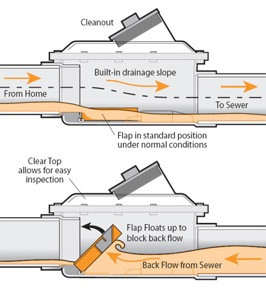 Backwater sanitary valves (also known as "check valves" or "backwater valves"), are mechanical devices that are designed to allow the flow of water in one direction only: away from your home. Used on a sanitary lateral, they can offer a decrease in risk of sewage backup if installed properly and maintained adequately.
Backwater sanitary valves (also known as "check valves" or "backwater valves"), are mechanical devices that are designed to allow the flow of water in one direction only: away from your home. Used on a sanitary lateral, they can offer a decrease in risk of sewage backup if installed properly and maintained adequately.
What is a backwater sanitary valve and how does it work?
A backwater sanitary valve is a type of check valve that is designed to only allow flow in one direction. Different backwater sanitary valves work in different ways, but in general, the type of device that is used in sanitary sewer scenarios works like this:
- The valve is normally in an open position: the "gate" (or "flap") is open.
- When a backflow condition occurs, floats under the gate lift up and start to block the backflow.
- If the backflow condition increases, the gate closes against a gasket and creates a seal which does not allow water to pass in the backwards direction.
- When the backflow condition ends, the gate falls back down due to gravity and returns to the open position to allow normal outflow of sewage from the home's plumbing system.
How do you install a backwater valve?
There are a couple different types of backwater sanitary valves, and they are installed in different ways. The most commonly used variety is called a Mainline Full-port Backwater Valve. It is installed by cutting a hole in the foundation inside the home above the main sewer line to expose it and allow for the installation of the device. There is another less common variety that can be installed somewhere on the sewer lateral outside the house, in the lawn for example.
The location of installation needs to be downstream of all fixtures to offer full protection, in addition to any other manufacturer's requirements that may exist. Installation of a backflow prevention device is not simple and this work is best undertaken by a licensed and qualified plumber, and it does require a Plumbing Permit from the City. Knowing if your foundation drain goes to the sanitary sewer or not is critical, and ideally, it should be redirected.
Why do you need a plumbing permit to install a backwater sanitary valve?
Because there are a number of code requirements pertaining to backwater sanitary valves, a plumbing permit is required for installation. A plumbing inspection will allow for confirmation that the contractor has installed it correctly. A note of caution: while contractors are aware of this, they do not always acquire a permit or even inform you that one is required.
 Cranbook
Cranbook


